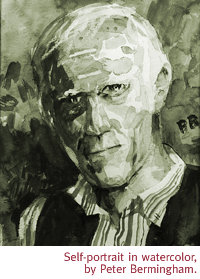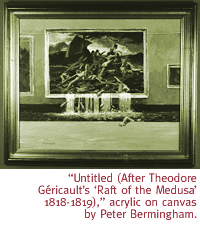
The UA Museum Of Art Housed A Real Treasure: Director Peter Bermingham.
By Margaret Regan
FOUR OR FIVE summers ago, Peter Bermingham the artist surfaced
in Davis Dominguez Gallery's Small Works Invitational.
The director of the University of Arizona Museum of Art, he had
contributed a deadpan fantasy of a museum in chaos.
Calling the work "Untitled (After Theodore Géricault's
'Raft of the Medusa' 1818-1819)," Bermingham painted a torrent
of water spewing out of the Géricault on a museum wall.
There was a dangerous, flooded moat right below the painting,
but a soaked survivor was pulling himself up to the solid ground
of the museum floor.
 Deftly painted in acrylics in traditional style, it was a hilarious
allegory of museum life, assigning the museum the role of savior.
The painting was my first inkling that Bermingham was an artist
himself. Until then, I'd known him only as the gentlemanly director
of a museum, one that seemed to run exceptionally smoothly. And
his unflappable demeanor never hinted at any fears about paintings
rising up in rebellion--or in flood.
Deftly painted in acrylics in traditional style, it was a hilarious
allegory of museum life, assigning the museum the role of savior.
The painting was my first inkling that Bermingham was an artist
himself. Until then, I'd known him only as the gentlemanly director
of a museum, one that seemed to run exceptionally smoothly. And
his unflappable demeanor never hinted at any fears about paintings
rising up in rebellion--or in flood.
The deluge painting has turned up again in the UAMA lobby, in
a new little show of a dozen or so Bermingham works full of ironic
commentaries in acrylic and watercolor. In "Art, Love It
or Be Shot," three artists in ranch duds frantically paint
a Tucson starry night--and a stuffed bull on wheels--under the
watchful eye of an armed cowpoke whose gun ensures they will not
deviate from the required western clichés. Another long
view of the Tucson valley, punctuated by a jaunty TUCSON! tourist
billboard, pictures smokestacks way bigger than the saguaros.
There are paintings that are thank-you notes to friends, and
at least one funny birthday card painting ("Ken Little Is
35" it screams in angry red letters that drip blood; it's
signed "Peter Bermingham, 42.") Then there are pure
landscapes, full of clouds and mountains and seas. Particularly
nice are the glistening mud flats of "Low Tide, Newport,
Oregon," a watercolor from last summer.
The impromptu show came together last week, within days of Bermingham's
unexpected death on January 30 at the age of 61. Bermingham had
had a heart attack December 20, but he seemed to be on the mend,
said Associate Director Lee Karpiscak, and had returned to work
part-time in January.
 "He wanted to come back to work," she said. "He
loved the museum."
"He wanted to come back to work," she said. "He
loved the museum."
On January 28, Bermingham collapsed in the museum where he'd
been director and chief curator for almost 21 years. That heart
attack was quickly followed by a third, and after emergency surgery
he died in the hospital, his family at his side. The museum shut
down entirely on Wednesday afternoon, February 3, so the staff
could attend his funeral ("He wouldn't have approved,"
said publicist Alisa Schorr); but the tribute show managed to
materialize by the next day.
"Everyone put that together," curator Peter Briggs
said. "It was just a spontaneous thing. Both past and present
staff members brought things in."
Prized by his staff for his wit and good nature, Bermingham to
me was the consummate professional, unfailingly polite, knowledgeable
and helpful. And endearing himself to my reporter's heart, he
always returned my calls promptly. I knew him mostly by the work
he produced, the changing exhibitions that had me traveling to
his museum at least half a dozen times a year.
Just in calendar 1998, I reviewed the museum's Tucson's Early
Moderns 1945-65, an intriguing look at the first intrusions
of modernism into the sleepy Old Pueblo; water-inspired photographs
and paintings by David Andres and Ann Simmons-Myers; The Last
Dance, a brutal border installation by Dennis Oppenheim that
featured ear-splitting radio music and swinging 3-D cacti armed
with sharp nails; Robert Colescott's jazzy painted meditations
on race, culture and gender; and Bailey Doogan's searing female
nudes in charcoal. The UAMA had a very good year as far as I was
concerned, and in my end-of-the-year arts review I awarded the
place Least Staid Art Museum.
"Peter's vision was cutting edge. We'll keep doing this,"
said Karpiscak, who has been named interim director through June.
Changing exhibitions are scheduled through the end of 2000.
Arriving at the museum from the Smithsonian, where he was curator
of education at the National Collection of Fine Arts, Bermingham
more than doubled the size of the UAMA collection, from about
1,500 to almost 4,000 pieces. He upped the number of annual changing
exhibitions from two to 12, curating or organizing some 200 exhibitions
during his tenure.
"He was a curator par excellence," said Karpiscak,
who joined the museum with Bermingham in 1978. The two had joked
about retiring at the same time in 2002. "He had a terrific
eye, and a wonderful breadth of knowledge. He was a generalist;
there are not too many like that now."
Curator Briggs agreed that Bermingham "read very broadly
and had insights even from the science perspective. He read in
philosophy, and last summer it was microbiology. Like a good humanist,
he had a broad foundation. But he readily deferred to me in Latin
American, pre-Columbian and Native American art. He didn't pretend
to know something about what he didn't know."
 When I interviewed Bermingham a couple years back about an upcoming
glass show at the UAMA, part of the citywide glass extravaganza,
he was characteristically honest. "What I don't know about
glass wouldn't take up three minutes of your time," he told
me. And though Bermingham had a doctorate in art history from
the University of Michigan, "he disdained at all costs putting
a Ph.D. or a Doctor in front of his name," Briggs said.
When I interviewed Bermingham a couple years back about an upcoming
glass show at the UAMA, part of the citywide glass extravaganza,
he was characteristically honest. "What I don't know about
glass wouldn't take up three minutes of your time," he told
me. And though Bermingham had a doctorate in art history from
the University of Michigan, "he disdained at all costs putting
a Ph.D. or a Doctor in front of his name," Briggs said.
Bermingham's son Chris, in a funeral eulogy, disputed the widespread
notion that his father was immoderately modest. No, he said, Dad
would regularly sneak into the library to see how many had been
checking out his scholarly books, two works on late 19th-century
American landscape painting. The younger Bermingham also shared
tales of a loving husband and a father devoted to his now-grown
children, four sons and one daughter. Once a Scout leader, he
still loved to hike Tucson's mountains, and he was an inveterate
golfer who would insist that Chris, at age 12, always retrieve
balls lost in the rough.
He never shirked from helping artists find their way, either.
He gave shows to numerous local artists, the well-known as well
as the up-and-coming, Michael Cajero, Catherine Nash, Jim Waid
and Nancy Tokar Miller among them. And he was always ready to
look at new artists' portfolios or pay studio visits. In the last
conversation I had with him, last summer, we talked about the
proposal by some downtown artists to start a new Museum for Contemporary
Art on Congress Street. Bermingham was no naif: He knew the difficulties
of running a museum, even with the institutional backing of a
large university. But he greeted the idea with characteristic
enthusiasm. And his thoughts inadvertently betrayed his own sense
of what he'd accomplished at the UAMA.
Let his own words be his epitaph.
"I'd love to see what (they) propose. It's not a bad idea.
The toughness of it adds to the sense of adventure. You pull it
off by growing."
Works by Peter Bermingham will remain on view through
February at the University of Arizona Museum of Art, in
the Fine Arts Complex southeast of Park Avenue and Speedway. Gallery
hours are 9 a.m. to 5 p.m. Monday through Friday, noon to 4
p.m. Sunday. A memorial service for Bermingham will take place
at the museum at a date to be announced. For more information,
call 621-7567.

|





